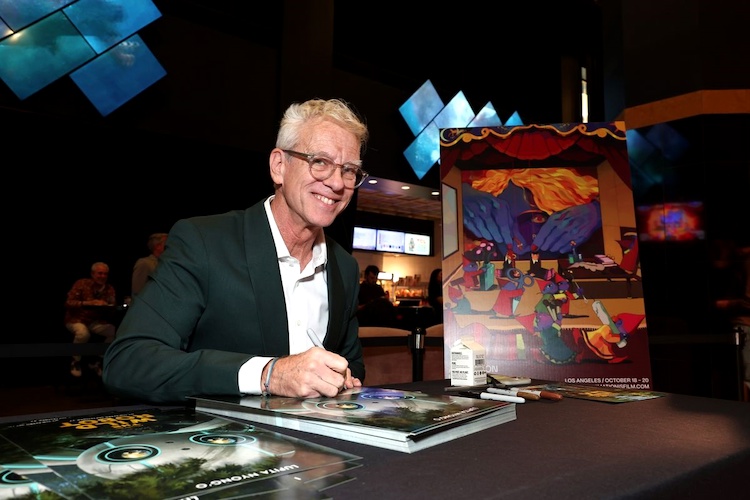Frames of Wonder: A Review of “Animation is Film Festival 2024” Highlights
Every year the great Animation is Film Festival, produced by GKIDS in partnership with Annecy International Animation Film Festival, takes residence at the Chinese Theater in Hollywood for a weekend to showcase a selection of exciting animation works new and old and this year was no exception. From award-winning features to student showcase shorts of every genre, there was something to entertain every audience member.
Aside from the many screenings and premieres, some of the highlights of Animation is Film are the chances to hear directly from some of the filmmakers. Here is a sampling of some of the wide variety of informative and entertaining discussions:
Filmmaker Masterclass: Chris Sanders & The Wild Robot

Longtime Disney animator Chris Sanders, well-known for creating and voicing the mischievous Stitch from Lilo and Stitch, spoke with Variety’s Chief Film Critic Peter Debruge about his career at Disney and then Dreamworks about some of his many features, including his latest, The Wild Robot.
–The popular marketing move to have Stitch interacting with the traditional Disney characters came from Sanders’ amusement that now for forever, they would have to put Stitch in with the rest of all these legacy Disney characters. “I ruined it."
–When brought in on How to Train Your Dragon, Sanders upped the stakes for the characters by making Toothless as the worse choice Hiccup could make.
–Moving on to Croods, Sanders felt it was important to emphasize that fear is often necessary for survival, but that ultimately people need to be able to change their minds and adapt beyond it.
–Creating The Wild Robot, Sanders recalls what a different experience it is now making a film in CG from when he wasn’t allowed to put a heart or a coffee cup on Lilo’s sister’s shirt because they couldn’t afford to animate it in all the sequences.
–Sanders felt that Wild Robot has the same type of visual breakthrough as Stitch did, using new technology to create a look that is dimensional but that has an analog warmth to it, and that by getting away from photorealism, you can achieve an overall effect that is more believable.
–Continuing with some of the themes from Croods, the core of The Wild Robot is that kindness can be a survival skill, as Roz has to change her programming if she’s going to survive.
–It is necessary to explain that Nature is harsh and sometimes fatal, otherwise there are no stakes. While they did not want to shy away from straight talk about death, they needed the story to ultimately be satisfying, and not a downer.
Special Talk & Live Drawing with Director Naoko Yamada
Naoko Yamada, Credit John Salangsang / Shutterstock for Animation Is Film
In conjunction with Japan House, The Colors Within director Naoko Yamada held a rare in-person talk and live drawing session where she spoke about her insights into animation and her creative process.
–While she appreciates CG animation, her preference is for hand-drawn animation, as she feels the process of creating art more when you do it with your own hands.
–In the course of her regular day, much of it is spent searching for exciting, interesting things to serve as inspiration.
–While drawing characters from The Colors Within, Yamada laughingly noted that the main character Totsuko’s “ahoge" was “very important."
[“Ahoge" refers to the hair or hairs on a character’s head that stick straight up–usually used in anime to identify foolish or careless/carefree characters.]
Filmmaker Masterclass: Inside Out 2
In this informative session, the writers behind Inside Out 2, the top-grossing animated film of all time, Meg LeFauve and Dave Holstein, gave tips on how they work to create writing that blends deep emotions with universal appeal.
–A lot of writing is reiteration. After a screening and subsequent notes, it’s often better to go back to outlining versus editing the same draft, because you don’t want to just change the symptoms of a story that doesn’t work.
–The human body can only take in so much information. In animation, so much is already presented visually, simpler dialogue works better.
–As an anxious parent, LeFauve related to Joy and her relationship with Riley. If you are brave enough to bring something that could be embarrassing to you, that will connect to people and make them feel seen.
–In the first act, you have to convince the audience that the situation is real by brainwashing them into the viewpoint of the main character. That way they can experience the change in perspective with them later in the film.
–You need to establish your goals for the first act. Is the story transformative, as in Inside Out 2, or is the character claiming their space in the world, as in Moana? Is the character changing or is the world changing?
–In a transformative storyline, the support poles are establishing the character’s views and relationships in the first act, and then waking up to them being wrong in the second act.
–"Your character has to want something. You need to figure out what’s their plan to get it, and then subvert it."
–Define your character by showing their choices.
–One trap is writing backwards from the theme and not forward from what your character wants.
–What is the character going to realize at the end of act two that was wrong before? That realization is what the film is about.
Moana 2 directors David Derrick Jr. and Jason Hand also gave a behind-the-scenes look at the new blockbuster, as Laughing Place earlier described.





